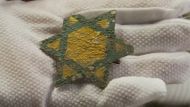A salvage operation is underway on Perth's Swan River to lift out wreckage of a seaplane that crashed during Australia Day celebrations, as new details emerge about the events leading up to the tragedy.
The WA Department of Transport is leading the delicate operation that began on Friday afternoon and started with the removal of the plane's tail, along with the fuel tanks.
More World News Videos
Plane crashes into river during Australia Day celebrations
A light plane crashes into the Swan River killing the two people on board during Australia Day celebrations in Perth.
"Our primary concern is maintaining the integrity of the site and wreckage for the purposes of the investigation by the Australian Transport Safety Bureau," Ray Buchholz from the Department of Transport said.
A dive team has already assessed the site and a crane, barge and a pollution response vessel are being used to extract the twisted metal.
Peter Lynch and girlfriend Endah Cakrawati died when the Grumman G-73 "Mallard" flying boat broke up on impact in front of horrified families on Thursday afternoon.
The seaplane stalled and nose-dived into the water about 5pm, breaking up on impact, as revellers looked on in horror.
There are reports that Mr Lynch raised concerns about the weather with friends prior to the fatal flight.
Pilot Mack McCormack told the West Australian Mr Lynch sent him a text message saying "my biggest concern is how hot it is today and the lack of wind."

Hot weather can affect a plane's performance, reducing lift from the wings, which can be compensated for by flying faster.
There are also reports that Mr Lynch only received clearance from Australia's Civil Aviation Authority to fly in the Australia Day aerial display the day prior.

Mr McCormack said Mr Lynch left a voice message on his phone saying "Guess what, mate, I got my type rating and everything through from CASA... and I am pretty happy about that as it means I will be in the show."
In a statement to WAtoday, CASA said Mr Lynch's aircraft was operating as part of an approved air display, which was given special permission to operate.
"Air displays over built up (suburban) areas, public gatherings and vessels on the surface of a body of water are not normally approved," CASA said in the statement.
"All aircraft operating as part of the air display sought and received approval from the Civil Aviation Safety Authority to do so.
"Under the regulations, except during take-off and landing, or where specifically approved as part of the program of events, the minimum height at which any aircraft may operate is 500 feet above ground level."
Eyewitnesses have described how the seaplane circled low over the river before turning hard to the left, stalling and falling into the water.
There are reports Mr Lynch may had been trying to do a touch-and-go manoeuvre - landing the seaplane briefly on the water surface and then taking off again.
Investigators are working to determine what led to the plane crashing, with two efforts running simultaneously - one spearheaded by WA police and another being coordinated by the Australian Transport Safety Bureau (ATSB).
Police will concentrate on determining the cause of death while the ATSB will look at air safety and technical issues, though both investigations will overlap.
ATSB investigators will spend the next few days examining the scene, interviewing witnesses, and collecting maintenance and pilot records and air traffic control data.
A final report is expected within 12 months.
- with AAP














